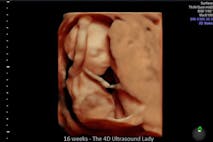
New Archbishop of Canterbury warns of danger in legalizing assisted suicide
Nancy Flanders
·
Abortion Pill Reversal·By Danny David
Twins saved from abortion after mother seeks abortion pill reversal
Medication abortion is one of the most common methods of ending the life of a preborn baby. In a medication abortion, a pregnant woman first takes pills which contain mifepristone — also known as RU-486 — then takes misoprostol 24-48 hours later. Together, these drugs work to make the mother’s womb a hostile environment for the new life inside, first acting to kill the baby and then expelling the dead baby from the uterus.
The procedure is explained in more detail by former abortionist Dr. Anthony Levatino in the video below:

The pro-abortion movement has fought hard to deny the facts about abortion reversal, but the truth is that many women reconsider their choice to abort after taking mifepristone. Furthermore, facts demonstrate that the effects of mifepristone can be reversed by the administration of progesterone, particularly if swift action is taken. Abortion Pill Reversal has a 24-hour, nurse-staffed hotline (1-877-558-0333) that connects women to a network of over 350 qualified doctors who help in abortion reversal.
A Pennsylvania woman recently shared her personal abortion reversal story with a local news outlet. A college student who did not wish to be publicly identified, the woman goes by the pseudonym Samantha. She told ABC27:
I had an unplanned pregnancy and I was thinking about abortion. I took the abortion pill and I had regret immediately, so I went to Google and started searching if there was any way to undo what I did, and I came across a reversal number and I contacted the number.
While the abortion facility failed to provide Samantha with any valid information on abortion reversal, should she change her mind and wish to expand her options, Samantha’s search led her to discover Hope Within. Hope Within is a community health center in Elizabethtown which offers free primary care services to low-income women or others who need health care without a long wait. Doctors at Hope Within were able to successfully reverse Samantha’s abortion by administering progesterone. An ultrasound discovered she had saved the life of not one, but two of her children. Samantha was pregnant with twins and later gave birth to a boy and a girl, who, according to ABC27, are “both now 1 year old and healthy.”
Dr. Matthew Weitzel of South East Lancaster Health Services explained the importance of progesterone in most successful abortion reversals (though some women outside the APR program have been known to carry healthy children to term after taking the mifepristone but skipping the misoprostol): “In the experience of the abortion pill reversal program, nobody has been able to carry a pregnancy more than 72 hours after [taking] the pill if they haven’t received progesterone,” said Weitzel. The program stands ready with hundreds of doctors around the nation, available to help women who seek abortion reversal.
Rebekah, who chose abortion reversal for her son Zechariah.

In a 2012 small case series published in the journal, “Annals of Pharmacotherapy,” Drs. George Delgado and Mary Davenport reported on seven pregnancies in which progesterone was administered, following ingestion of mifepristone. Of the seven, at least four reversals were successful, with the babies surviving. Two reversals were unsuccessful, and one of the seven women reportedly avoided attempts to follow up regarding the success or failure of the reversal.
While some pro-abortion advocates are quick to challenge abortion reversals by pointing to limited research and the fact that some preborn babies survive following mifepristone without the administration of progesterone, administering progesterone to counter the effects of mifepristone — which works to block naturally produced progesterone — adds up medically. Progesterone has been used safely in pregnancy for decades, including to combat infertility and to prevent miscarriages. Even a clearly biased New York Times Magazine article on abortion reversal admits the success of abortion reversal with progesterone.
In the article, Dr. Harvey Kliman, director of the reproductive and placental research unit at the Yale School of Medicine, claimed that administering progesterone as an abortion reversal “makes biological sense,” and that he believes it “is actually totally feasible.” Interestingly, in addition to the author of the article being clearly biased, Kliman is himself pro-abortion. Yet both acknowledge that abortion reversal is working for women.
Amy Mendoza’s son Cruz was saved by abortion reversal.

While extensive research on abortion reversal is still in the works (naturally, as reversals are relatively young and innovative), stories like Samantha’s can no longer be considered anomalies. There are many such stories from women all around the nation, some of which can be seen here, here, and here. While not all women regret abortion or hope for a second chance at life following ingestion of mifepristone, many do. If one truly believes in “choice,” one should at least respect the choice of women to seek treatment to reverse their abortion. Women have the right to know that abortion reversal is possible, and those who believe in choice should spread the information about this medical reality.
Summer and her boyfriend found abortion reversal and saved their daughter, Finley.

Live Action News is pro-life news and commentary from a pro-life perspective.
Contact editor@liveaction.org for questions, corrections, or if you are seeking permission to reprint any Live Action News content.
Guest Articles: To submit a guest article to Live Action News, email editor@liveaction.org with an attached Word document of 800-1000 words. Please also attach any photos relevant to your submission if applicable. If your submission is accepted for publication, you will be notified within three weeks. Guest articles are not compensated (see our Open License Agreement). Thank you for your interest in Live Action News!

Nancy Flanders
·
Guest Column
Liberty Counsel
·
Abortion Pill
Isabella Childs
·
Guest Column
Lisa Bourne
·
Abortion Pill Reversal
Nancy Flanders
·
Abortion Pill
Carole Novielli
·
Issues
Danny David
·
Issues
Danny David
·
Newsbreak
Danny David
·
Newsbreak
Danny David
·
Human Interest
Danny David
·